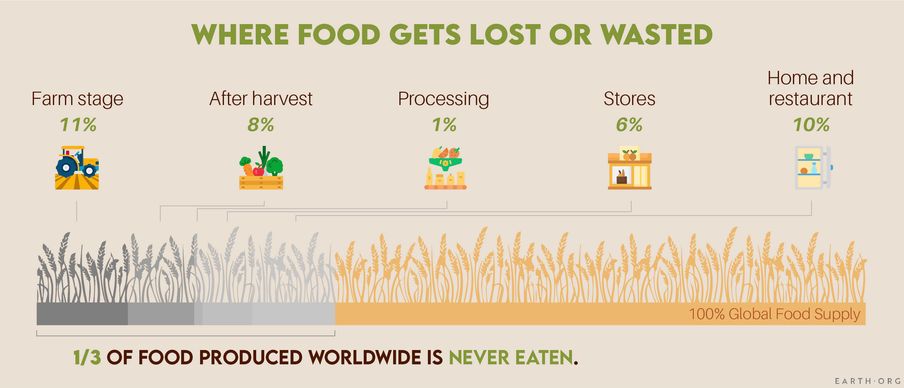Food waste is food that is intended for human consumption that is wasted and lost, and can occur anywhere throughout the entire supply chain from farm stage to harvest to households.
—
It’s undeniable that food waste is one of the biggest environmental problems of our lifetime. It’s an issue not just prevalent in the rich, developed nations, but occurring in all parts of the world. Yet according to the Food and Agriculture Organisation (FAO) of the UN, there are currently more than 800 million people facing hunger and suffering from malnutrition around the globe, equivalent to 11% of the global population. That number has notably climbed in the wake of the COVID-19 pandemic. But what exactly is food waste and how much food is wasted in the world?
What Is Food Waste?
Food waste is food that is intended for human consumption that is wasted and lost, and refers not only to food that consumers don’t finish at restaurants and are thrown out at home, but also raw materials and produce that are lost in the farming stage, harvesting processes, during transportation, and storage. Food waste can occur anywhere throughout the entire supply chain.
Shockingly, about one third of global food supplies are wasted or lost, potentially as much as 40% of food or 2.5 billion tonnes around the world is wasted every year. If food loss were a country, it would be the third largest greenhouse gas emitter, behind China and the US. The amount of food loss across the world would make up the size of a country as big as India and Canada combined.
The volume of food waste globally is enough to feed three billion people, while food waste in Europe could feed 200 million people, in Latin America 300 million people and in Africa 300 million people.
Food waste has significant effects on the environment, global and national economies, food security and nutrition. The increasing and persistent global demand for food is also driving fertile land useless while contributing to more land degradation and deforestation, which as a result, destroys our precious natural habitats and biodiversity, limiting the services that they provide and disrupting entire ecosystems.
By mid-century, the world population will likely hit 9 billion people, which means global food production must increase by 70% to meet this demand. The failure to keep up with food demand will create a food shortage and a humanitarian crisis not seen before on this scale. It is urgent for us to address the global food waste problem and ensure the world adopts a global sustainable food supply.
You might also like: 25 Shocking Facts about Food Waste
Countries that Waste the Most Food
In developed countries, more than 40% of food losses occur at the retail and consumer levels and in households. While dense population countries such as China and India produce the most household waste every year, the biggest food waste countries per capita are countries like Nigeria, Greece and Australia. In comparison, the average volume of food waste generated per capita in China is about 64 kg, while the people in Australia produce an average of 102 kg of food waste a year.
Fresh fruits and vegetables are the most commonly disposed of food, many of which are thrown out at the retail level due to quality standards, emphasising appearance over its functionality. Half of all produce is thrown away in the US because it is deemed too “ugly” to eat, amounting to 60 million tons of fruits and vegetables every year.
In developing countries, 40% of losses occur at the post-harvest and processing stages.

According to a latest report by the World Wide Fund (WWF), 15% of all food produced globally is lost during the farming stage, which amounts to 2.2 giga tonnes of CO2 a year. That is equivalent to 4% of global anthropogenic emissions, and about 6-8% of global food loss emissions.
You might also like: How to Reduce Food Waste


















